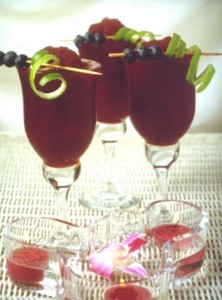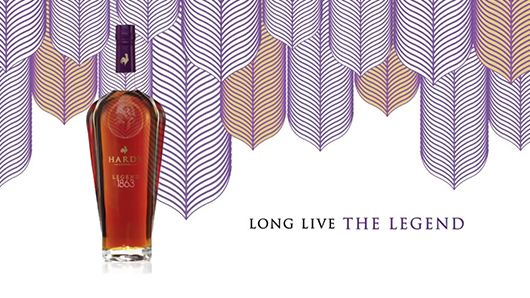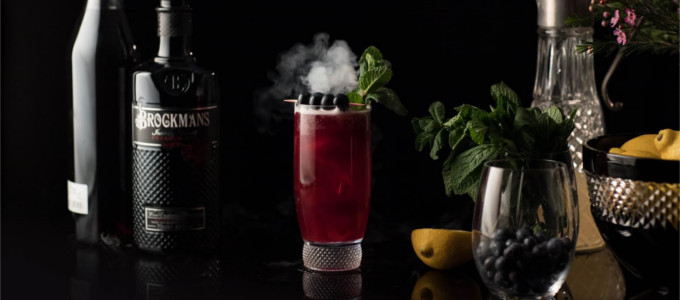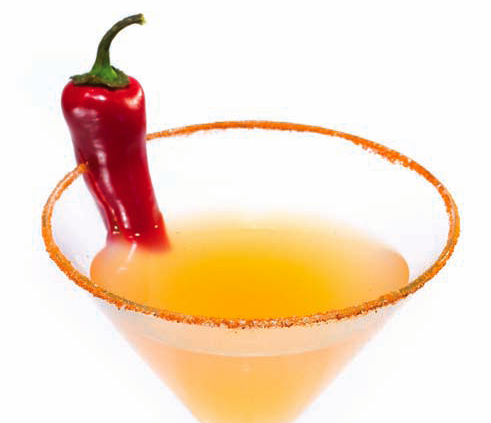Blueberries offer a pleasant flavor as is or when combined with other fruit flavors.
Blueberry juice, puree and other liquid blueberry products are available from suppliers across the USA and Canada. Blueberries have a sugar/acid ratio which makes them desirable for blending with other high acidic juices. Blueberry juice contains about 12% sugar, and a low acid content of about 1.9%. Blueberry juices which integrate the skins of the blueberry benefit from the anthocyanin in the pigment.
Blueberries are being formulated into fiber drinks, which are increasing in popularity. They work well with blueberries which make the drinks a delicious way to get natural antioxidants. In addition to tasting good, fiber beverages that contain blueberries can be positioned as real food containing natural antioxidants, not synthetic elements manufactured in a lab. With whole food plant sources like blueberries, beverages supply natural antioxidants and other beneficial nutrients from the plants which are most efficiently absorbed by the body.
From healthy juices and beauty-from-within beverages to nouveau nonalcoholic cocktails, blueberries are synergistic with many ingredients, herbs and spices, among them ginger, cocoa, chocolate, caramel, lemonade to name a few.
With regard to innovative flavor trends in blueberry containing beverages, this is an area where beverage designers seem to be working like a blue streak to provide the market with close encounters of the blue kind.
No doubt this is because the market sees that consumers, from their health to their hedonics, no longer have to be convinced of the value of blueberries; since people already associate blueberries with goodness, wholesomeness and even happy memories, beverage product designers and formulators of all kinds are developing concepts and introducing products with blueberry-blue cache.
Blueberry beverage ideas also include “culinary” cocktails, Punch and Blueberry, Blueberry Breakfast Beverages; Drinkable Blueberry Crème Brulee Shake; Drinkable gelatos like Starbucks Sorbetto; Combos like Blueberry Cobbler Shake, frozen or simply very chilled.
The Drinkable Dessert category is very big now, with chefs whipping drinkability into classics such like blueberry cheesecake, blueberry pies and even blueberry muffins. The use of blueberries in formats like powders, concentrates or purees makes for fruit-flavored creations, no matter the season.
Unique values blueberries bring to a beverage:
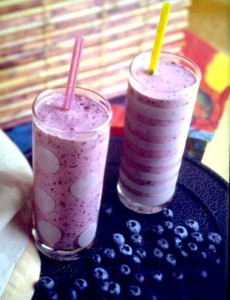 Beverage formulators know they can put blueberries on the label and take advantage of the image of blueberries as a healthy, delicious fruit full of natural goodness and enhancing the positive associations of comfort food. These products can feature blueberries as a food that people look forward to including in their diet every day. In fact, research shows that people want a blueberry in every bite in blueberry-identified products. There are already blueberries in a realm of juices and beverages that make the claim for antioxidants.
Beverage formulators know they can put blueberries on the label and take advantage of the image of blueberries as a healthy, delicious fruit full of natural goodness and enhancing the positive associations of comfort food. These products can feature blueberries as a food that people look forward to including in their diet every day. In fact, research shows that people want a blueberry in every bite in blueberry-identified products. There are already blueberries in a realm of juices and beverages that make the claim for antioxidants.
Blueberries are customarily listed among superfoods due to their high antioxidant property and potential to reduce the effects of age-related loss in brain function. There is always a lot of interest in blueberries as superfruits, especially since blueberries are often referred to as the original Superfruit.
Consumers equate blueberries with antioxidant power and consequently readily accept as an ingredient in almost any product. People look forward to eating blueberries both out of hand and as a delicious ingredient in their favorite prepared foods and beverages.
A recent article on functional foods (Nutraceuticals World, November 2011), discusses how blueberries benefit from the current consumer preference for foods with natural and intrinsic health benefits. As stated by Professor David Hughes, Emeritus Professor of Food Marketing at Imperial College London: “If you are pushing in the direction people want to go in, it’s much easier.”
In a sense their inclusion gives the product a homey and familiar touch and that warm halo effect characteristic of blueberry-anything. Not only do blueberries have an all-American association, as a native American fruit they are an excellent choice for product developers who want to project a responsible carbon footprint.
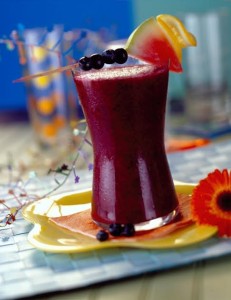 Convenient blueberry formats provide sweetness and the advantage of enriching products naturally. Blueberries and blueberry formats can mean reductions in sugar, high-fructose corn syrup, or other sweeteners. The inclusion of natural blueberries means clean labels and the ability to tout the product’s nutritional benefits. They add real flavor bursts and mouth feel. Blueberries in the ingredient statement say “wholesome” and “natural” and consumers view blueberries as a value-added, healthy ingredient.
Convenient blueberry formats provide sweetness and the advantage of enriching products naturally. Blueberries and blueberry formats can mean reductions in sugar, high-fructose corn syrup, or other sweeteners. The inclusion of natural blueberries means clean labels and the ability to tout the product’s nutritional benefits. They add real flavor bursts and mouth feel. Blueberries in the ingredient statement say “wholesome” and “natural” and consumers view blueberries as a value-added, healthy ingredient.
With regard to beverage formulation, blueberries have always been popular because of their amazing versatility: fresh, frozen, IQF (Individually Quick Frozen), purees and plump osmotically preserved blueberries, which add color, texture and lush taste. In innovative smoothies and dairy drinks, they can add intriguing effects like blue swirls and patterns, and are essential in almost anything red, white and blue. Blueberry color and texture complement smooth, creamy dairy drinks, add mouthfeel interest, and a sweet-tart blueberry flavor that is a welcome contrast. Legend has it that blueberries were the original smoothie ingredient in food service—all you needed was frozen blueberries, a blender and a button to push! Jamba Juice includes blueberries in their most popular smoothies chock full of rich ripe blueberries. Blueberries with their natural high sugar levels help to remove the sour taste sometimes associated with yogurt and naturally sweeten the product. The fresh appeal is also attractive to health conscious consumers. Now drinkable yogurts are utilizing blueberries and blueberry purée to impart a natural taste and blue appeal.
Formats that work particularly well in beverage formulations include Single Strength Juice which is made from fresh berries crushed, pressed, filtered, pasteurized, packaged and frozen. Brix: 8.0 – 12.0; pH: 2.8 – 3.4.
Typical packaging:
Plastic pails: 5, 6 gal. (18.9, 22.7 l.); 28, 30, 60 lb. (12.7,13.6, 27.2 kg.).
Poly-lined metal drums filled to desired Brix levels.
Storage: 0° to -10°F (-18° to -23°C)
Blueberry Juice Concentrate is made from fresh blueberries, crushed,heat/enzyme treated,
vacuum concentrated, packaged and frozen.
Brix: 45.0, 65.0
pH: 2.1 – 2.7
Typical packaging:
Plastic pails: 5, 6 gal. (18.9, 22.7 l.); 50, 66 lb. (22.7, 29.9 kg.).
Poly-lined metal drums filled to desired Brix levels.
Storage: 0° to -10°F (-18° to -23°C)
For smoothies and other beverages, Frozen IQF blueberries are especially suited as well as abundant. Available year-round in Consumer packs: poly bags. Bulk: Poly lined corrugated cartons; 10-50 lb (4.5 – 22.7 kg), poly-lined metal drums: 270 lb (122.5 kg). They provide fresh fruit identify in any formulation where fruit identify is important. Storage: 0° to -10° F (-18° to -23° C)
For tea formulations, Blueberry powder is available made from fresh or frozen blueberries or puree, drum dried and ground into powder or flakes to specifications. Moisture Content: 3-5%, various screen sizes and granule consistency is available. It is stable at room temperature for three months; after that, storage is at 40°F.




